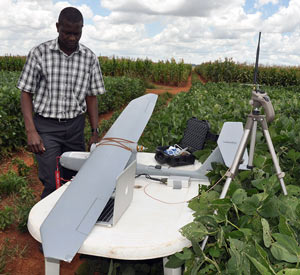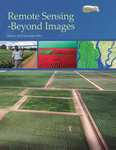
Remote sensing prepares for liftoff
14-15 December 2013, Mexico City

CIMMYT held a first workshop entitled ‘Remote Sensing: Beyond Images’ on 14-15 December 2013, joining a community of remote sensing experts, breeders, agronomists and policy makers to discuss turning their research and experience into useful tools to benefit farmers and increase food production while safeguarding the environment.
The event was sponsored by the Bill & Melinda Gates Foundation (BMGF), the Mexican Secretariat of Agriculture, Livestock, Rural Development, Fisheries and Food (SAGARPA) and the Sustainable Modernization of the Traditional Agriculture (MasAgro), CGIAR research Program on Maize, and the Cereal System Initiative for South Asia (CSISA).
Remote sensing makes it possible to observe the dynamics of anything from single plants up to entire landscapes and continents as they change over time. This can result in tools to advance agronomy by providing new information about weather, crop performance, resource use and the improved genetic traits sought by crop breeders. It may also help global agriculture to meet the challenge of achieving more with fewer resources, and of including more farmers in innovation. If methods can be found to share and connect this data, farmers will also benefit from greater transparency and more informed policymaking.
Opening the workshop, Thomas Lumpkin, Director General of CIMMYT, reminded participants of the urgency of meeting growing demand for staple crops while overcoming crop diseases, resource scarcity and climate change-induced stresses.
Technologies and data processing tools have become available to the point where researchers can now see remote sensing making an important contribution. As Stanley Wood, BMGF Senior Program Officer said, “For thirty years the remote sensing community has been on the cusp of doing something wonderful, and now we believe it can. What excites us is the amount of energy and enthusiasm, and the knowledge that their work is important.”
A Changing Landscape
Those present from the remote sensing community included practitioners from national government agencies, private sector service providers, donor organizations and researchers. The diversity of participants enhanced the breakout sessions, in which groups of participants planned viable remote sensing solutions using a business model approach.
The first session of presentations explored end users’ needs and expectations. Channeling the donor and policymaker viewpoint, Wood said that “the landscape is changing; we need actual development brought out. Let’s look for specific use cases.” The long term sustainability of projects lies in better public-private engagement, he emphasized.
Advancing Genetics from the Air
Workshop participants discussed in detail the various sensing and data-processing methods used to gather information about plants and agricultural systems from afar. For example, images taken by cameras in the thermal to visible end of the spectrum can reveal a broad range of plant characteristics such as biomass, water use and photosynthesis efficiency, disease spread and nutrient content. Radar or light radar (LiDAR) imaging can be used to map the physical structure of plants from the canopy down to the root system beneath the soil at a detailed resolution.
When mounted on an unmanned aerial vehicle (UAV), these sensors can rapidly survey much greater areas of land than is possible with measurements made on the ground, even in inaccessible areas. It is hoped that such research will open the way for plant breeders to design larger and more efficient experiments to improve crops for farmers using high-throughput phenotyping.
Tools for Policymakers
Satellite imaging services such as NASA’s Moderate-resolution Imaging Spectroradiometer (MODIS), Landsat, and several commercial data providers ensure that researchers have access to a rich set of data covering the entire Earth. These data are being used for landscape analyses and for targeting new technologies.
The Group of Twenty (G20) recognized the importance of predicting food availability with remote sensing when it mandated the Group on Earth Observations Global Agricultural Monitoring (GEOGLAM) Initiative to develop a global yield prediction service. GEOGLAM is now working with partners in Tanzania and Uganda to adapt their tools for smaller scales.
Reaching the Farmer
Several presentations showcased how remote sensing can be used to the benefit of smallholder farmers. The Drought Tolerant Maize for Africa (DTMA) project for example is looking at using rainfall data to target its interventions for the greatest impact.
Bruno Gérard spoke about the challenges of CIMMYT’s work in helping smallholder farmers to practice a “more precise agriculture.” The spread of mobile phones and information and communications technologies (ICTs) in the developing world shows the potential for CIMMYT to bring recommendations derived from remote sensing to farmers, and allow them to provide their own input.
In this spirit, the workshop ended as it began, with a panel discussion on how to develop remote sensing services that will be taken up by the intended users. The intended outcome of the workshop is to provide the strategic direction to drive a new generation of remote sensing applications that can bring real benefits to farmers.
Resources
Program, Abstracts and List of participants
Presentations
How to cite presentations: Surname, Initial. 2013. Title of presentation [PowerPoint slides]. Presentation at workshop, Remote Sensing: Beyond Images, 14-15 December, Mexico City. Retrieved from: [website address] (date last accessed).
e.g. Cossani, C.M., and Reynolds, M.P. 2013. Approaches and the needs of remote sensing in phenotyping for plant breeding [PowerPoint slides]. Presentation at workshop, Remote Sensing: Beyond Images, 14-15 December, Mexico City. Retrieved from: https://www.slideshare.net/CIMMYT/approaches-and-needs-of-remote-sensing-in-phenotyping-for-plant-breeding (13/1/2013).


